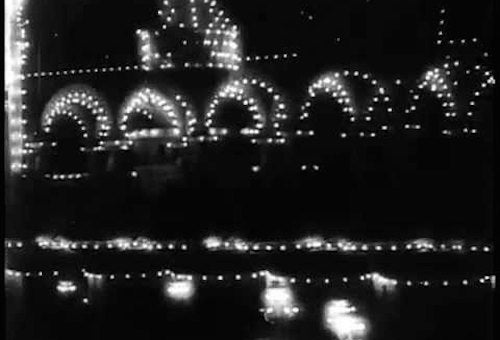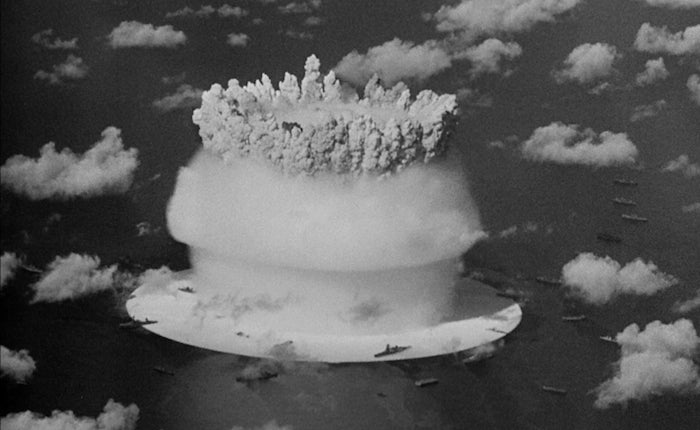
Coney Island at Night (1905)
Recently in New York, I visited the new, beautiful Whitney Museum downtown on Gansevoort Street, just where the High Line park begins, to see their “expanded cinema” exhibition, Dreamlands: Immersive Cinema and Art, 1905-2016. Expanded cinema was a concept first proposed in 1970 by Gene Youngblood in his book of the same name, denoting filmmaking’s use of new technology, including film special effects, computer art, video art, multimedia environments and holography, but that was back in a mostly analog world, whereas the present exhibition and accompanying film program is to a large extent digital, whether digitized from analog moving image media or born digital. It is a bit of a sequel for curator Chrissie Iles’ 2001 exhibition, Into the Light: The Projected Image in American Art 1964-1977, down to the look-alike catalog covers, but also breathtaking, even when the work is familiar.
Iles writes on the introductory panel that Dreamlands “explores the ways in which artists have used the moving image to articulate technology’s dramatic influence on how we see and experience the world. In a series of immersive works, the elements by which cinema is traditionally known – projection, film, a screen, darkness, linear narrative – are dismantled and reassembled in new forms that are barely recognizable as having any relationship to cinema at all.” I would argue, however, that the exhibition actually theoretically explores and points towards different notions of cinema, beyond the false dichotomy of classic Hollywood narrative that the curator is referring to, taking cinema and putting it in an art gallery.
Destruct Film (1967)
For example, a prominent feature of Jenny Perlin’s Twilight Arc (2016) is the 16mm loop projector that throws Desmet-tinted, black-and-white, abstract, hand-drawn, animated images, consisting of color and printed words, onto a white wall. The colors are based on a color scale invented by Louis Bertrand Castel (1688-1757), who also first attempted to create a color organ, and thus refers to the long line of artist/composers who have attempted to visualize music. Jud Yalkut’s installation Destruct Film (1967) also features projection technology (film and slide projectors, motorized beam-splitters) in a darkened space, while viewers walk on old film prints strewn on the floor. Likewise, Stan VanDerBeek’s Movie Mural (1968) is a multimedia, multi-screen collage of found footage with the projection equipment placed squarely in the center of the space.
Raumlichtkunst (c.1926/2012)
The show actually opens with Edwin S. Porter’s Coney Island at Night (1905), ostensibly a 2 ½-minute documentary of amusement park lights that is viewed on a wall-mounted flat screen the size of your average painting, which obliterates the film’s original iconic signification, turning the images into purely abstract forms of light and movement. Joseph Cornell’s avant-garde film, Rose Hobart (1936), a reediting of a black-and-white Hollywood film, East of Borneo (1931), projected through blue filters, receives the same treatment, creating a moving painting and distancing the viewer even further from the film’s impenetrable narrative. On the other hand, Oskar Fischinger’s Raumlichtkunst [Space Light Art] projects three abstract animated films side by side to create a widescreen montage of light, color and movement, accompanied by Edgar Varese and John Cage.
Factory of the Sun (2015)
Right next to Porter’s film, one can lie down on big, foam blocks and take in both the surviving black-and-white (1926) and recreated color (1970) film documentations of Oskar Schlemmer’s Das Triadische Ballett [Triadic Ballet], the latter projected on a large screen. That work by the Bauhaus master references another of the exhibition’s themes, namely the technologically mediated body, whether human, cyborg, or anime. Similarly, Hito Steyerl’s Factory of the Sun (2015) not only translates recordings of human body movements into computer-generated imagery of mock newscasts, drone footage, and the artist’s personal narratives, but also imbeds the screen in a 3-D room that visualizes a computer grid. Just as the internet and computers eliminate the boundaries between various levels of reality, so too does the installation take our real bodies and insert them into a seemingly virtual space. At 23 minutes, the piece was longer than I had time for, but not as long as Alex Da Corte and Jayson Musson’s Easternsports (2014), a 152-minute work, involving four large screens in an art directed set with music by Devonté Hynes that reimagines Thornton Wilder’s “Our Town” at half speed.

Crossroads (1976)
Just how the environment can modify the character of moving images is demonstrated by Bruce Conner’s Crossroads (1976), his montage of U.S. government footage of the atomic bomb test on the Bikini Atoll in July 1946. The digitized 35mm material is projected on a huge floor to ceiling screen, but it is the music by Patrick Gleeson and Terry Riley that accentuates the sense of extreme dread as the slow motion, but deadly radioactive cloud engulfs ships and men in the foreground. At other times, the film, which was preserved by UCLA Film & Television Archive, appears almost abstract as clouds and sea degenerate into patterns of light, leaving only the memory of those sailors doomed to die of radiation poisoning and cancer.
< Back to Archival Spaces blog






 Mobile Navigation
Mobile Navigation

